Easily accessible alpine-style climbing, an amazing setting, and a modest grade make Shoestring Gully a must-do climb for ice climbers of all levels.
An ascent of Shoestring Gully in New Hampshire’s Crawford Notch is a rite of passage for aspiring ice climbers in the Northeast. Offering 2,500 feet of varied climbing, an incredible view of Crawford Notch, and an alpine feel without the above-treeline weather and exposure, Shoestring Gully is perhaps the best moderate ice climb in New Hampshire.
Quick Facts
Distance: Roughly 4 miles roundtrip and 2,200 feet of elevation gain
Time to Complete: Half day
Difficulty: ★★★ (WI2, Grade III)
Scenery: ★★★★
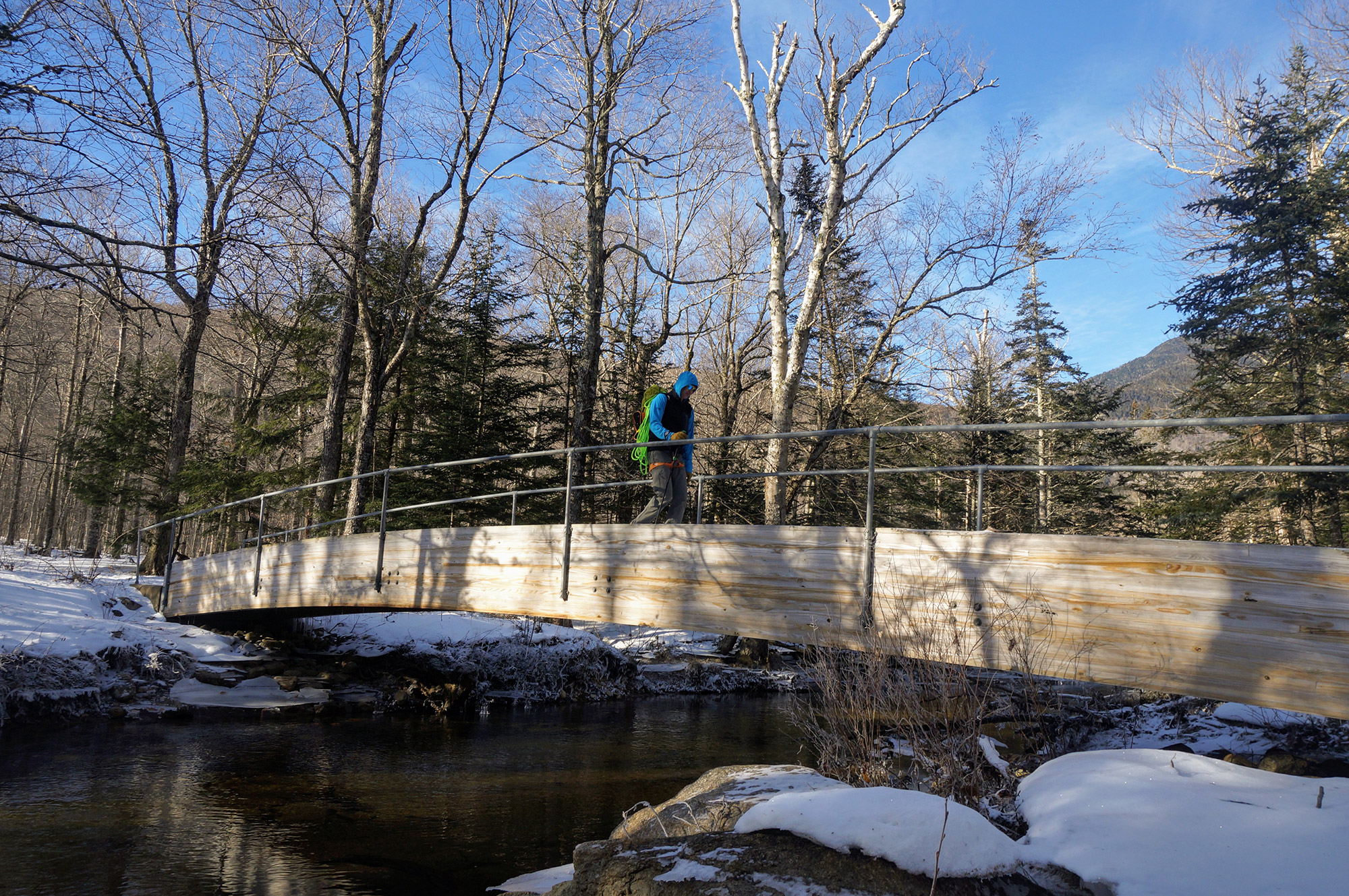
Turn-By-Turn
Getting There
Shoestring Gully is located off Route 302 a few miles south of Crawford Notch and the AMC’s Highland Center, with the best parking at the Webster Cliff Trailhead (44.170673, -71.388153). The parking area has enough space to accommodate five to ten cars, but space fluctuates depending on snowfall. This is a popular climb and parking spots fill up quickly—there’s additional parking available along 302 in both directions, but will add roughly an extra half-mile of hiking (in each direction) to your outing.

Acing the Approach
From the Webster Cliff Trailhead, the most straightforward approach to the gully is crossing Route 302 and hiking up the Webster Cliff Trail. The trail is flat and after a few minutes of walking comes to a bridge that crosses the Saco River. Take the bridge across and at the trail junction slightly uphill from the river (44.171936, -71.385475), turn left (upstream) onto the Saco River Trail. The trail is often icy; if you find that’s the case, this a good spot to put on either MICROspikes or crampons.
Follow the Saco River Trail for approximately 0.5 miles until you see the climber’s path leading uphill on the right (44.175751, -71.391571). Looking for a clue that this is the right gully? There’s a large boulder with painted trail markers for the Saco River Trail that makes a great landmark for heading uphill. Also, thanks to the popularity of this climb, the approach heading uphill is usually pretty broken in.
Pro Tip: Historically, climbers have approached the climb by parking roughly a half-mile farther north on Route 302 and crossing the Saco at an old dam. Over the years, the crossing has gotten a bit spicy. Although this puts you directly below the gully and shortens the approach, it also means a road march back to the car on the descent.
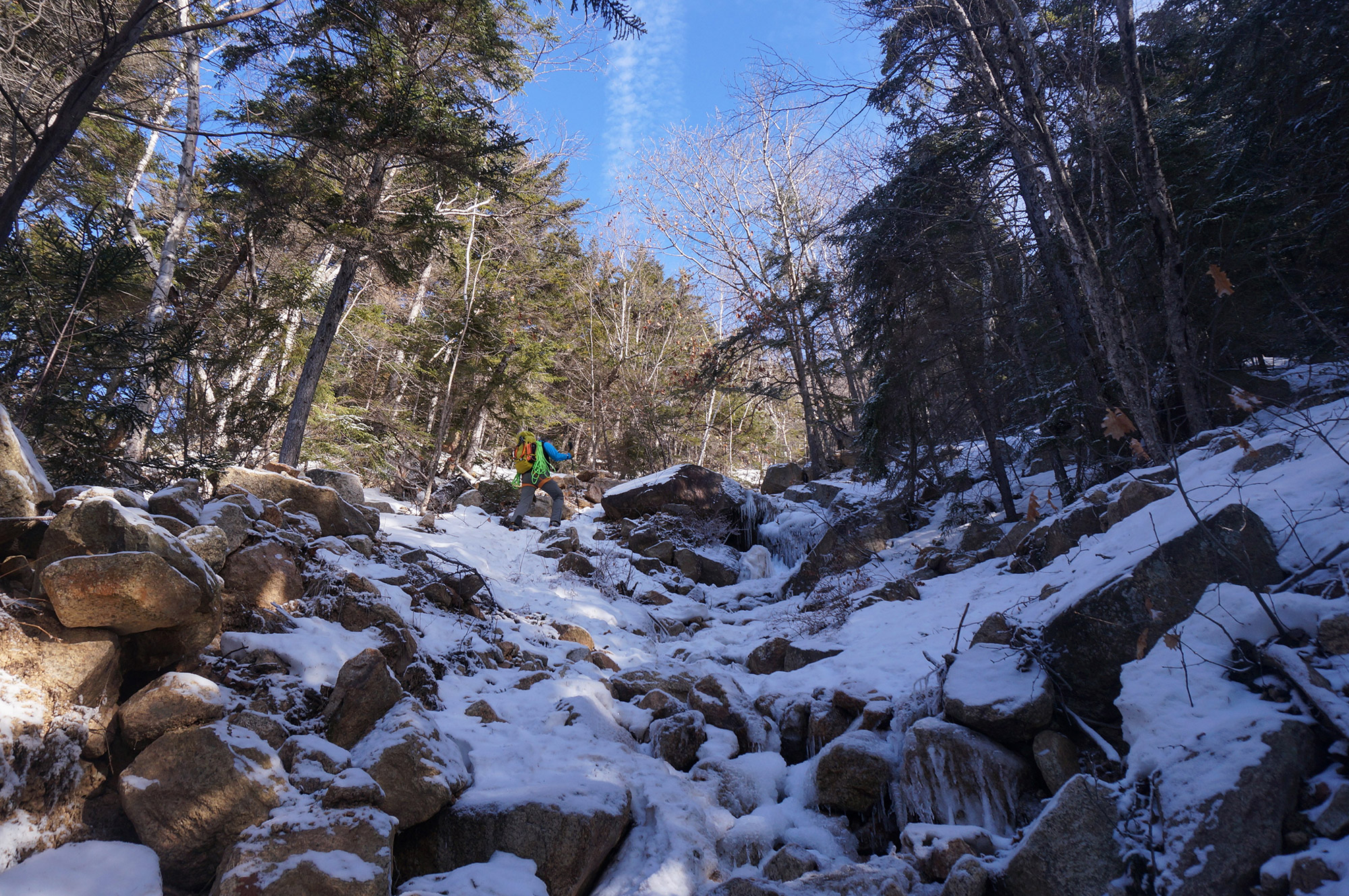
Getting to the Start of the Climbing
The climber’s path slowly gains altitude as it steadily moves into Shoestring Gully. Once in the gully, the trail steepens as you ascend a bouldery streambed that gradually opens up near the first ice flow. If you haven’t yet put on your crampons, this is the place to do so, as this section is often slippery and the “real” climbing is fast approaching.
After roughly 1,000 feet of elevation gain, climbers will encounter the day’s first ice flow (44.178432, -71.386986) at the top of the stream bed. Just below this bulge, there is usually a well-worn flat spot that’s perfect for getting kitted—harness, helmet, crampons, ice tools, rope, and protection—for the climbing above. It’s also a convenient place to have a drink and a quick bite to eat before the rhythm and mechanics of climbing are involved. From the trailhead, it’s about 45-60 minutes to get here.
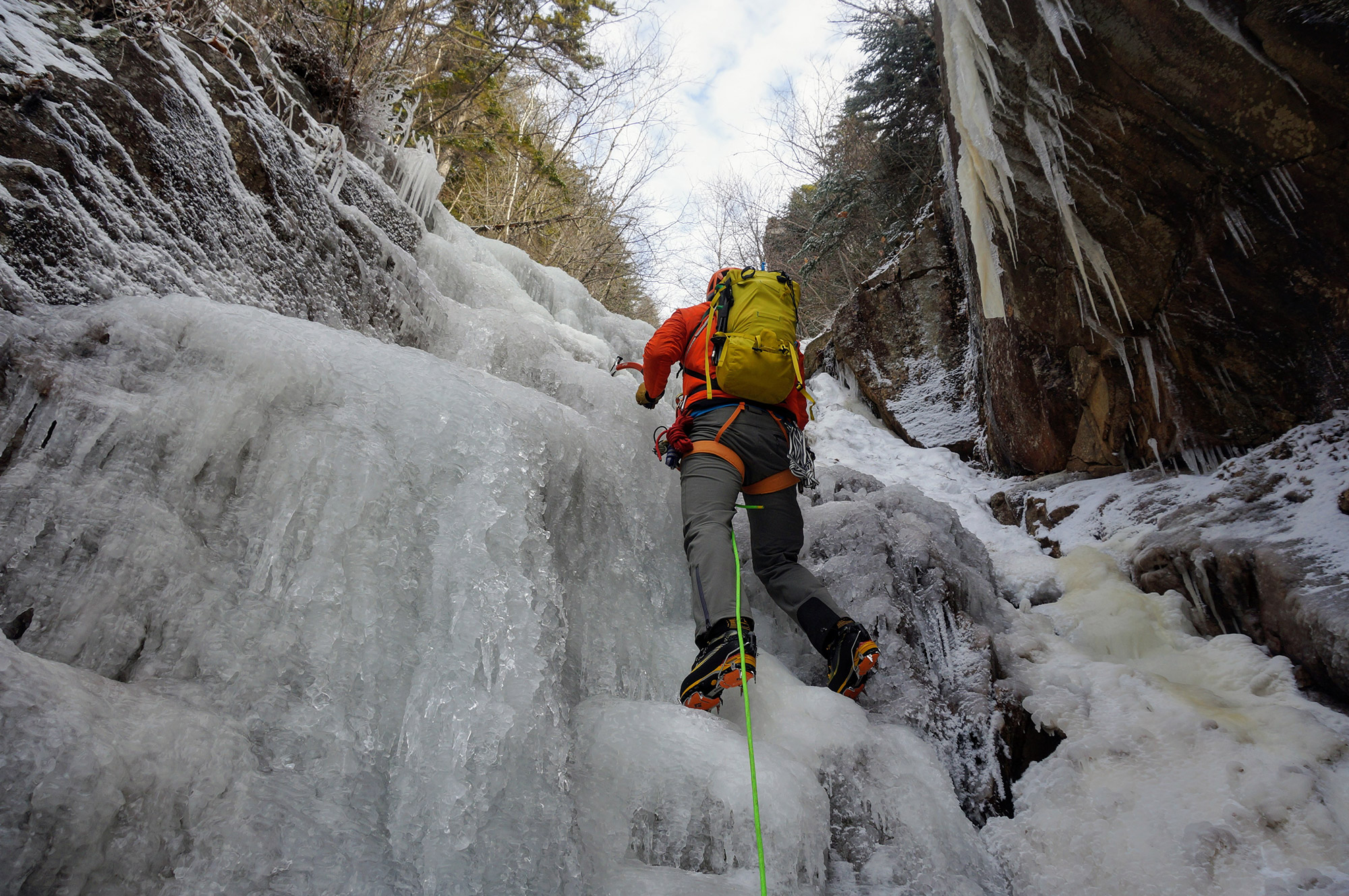
The First Ice Bulge
Most years, Shoestring Gully has a short (20 to 30 foot), moderate ice bulge at the base of the climb. This bulge is typically less challenging on the right side, but one of the joys of Shoestring Gully is the opportunity to increase or decrease the climbing difficulty to meet your skill level. On top of the bulge, climbers will find trees on both the left and right sides of the gully to use as anchors. Building an anchor on the left side offers a better view of followers while building it a little higher on the right provides an easier transition to the snow pitches that follow.

The Snow Pitches
After the first ice bulge, the next few rope lengths of the gully typically consist of moderate snow with a few interspersed ice patches. Climbers use a variety of techniques to move through this terrain depending on experience, comfort, and conditions. Some parties will simply pitch out the snow as they would on any other type of multi-pitch climb. Other parties will shorten the rope and simul-climb, that is, climb together with running protection between them. No matter how you choose to approach this terrain, the ice patches and occasional trees on the gully’s sides provide protection and anchor opportunities.
This section is also a great place to give your calves a break and show off your French technique (or practice it) thanks to the angle and nature of the snow. When the snow starts to transition to ice, the pitch begins to steepen and the walls grow in prominence—build an anchor, and get ready for the day’s most technical climbing (44.17893, -71.385422).

Climb Some Ice
The next three to four rope lengths are Shoestring’s “Ice Pitches.” It begins with a one- to two-pitch climb up several steps of moderate ice, eventually transitioning to steep snow. The most consistent ice in this section is typically on the right side of the gully.
After a brief snow climb, the gully widens and becomes comparatively steeper. From here, there are three ways up. The rightmost variation climbs the line that hugs the wall on climber’s right and is generally considered the easiest route. The center variation heads directly up the middle of the gully, putting climbers on steeper—closer to WI3—and more difficult ice. Heading farther left puts you on even slightly steeper ice. Beware not to take the fun climbing on the far left variation too high, as it eventually climbs out of the main drainage and will require some bushwacking to get back on course.

No matter which option you choose, the gully narrows after about two more pitches with the terrain turning into a combination of snow with intermittent ice patches. Trees line the left side of the gully providing some protection and anchor-building opportunities. After roughly one and a half rope lengths of snow-ish climbing, exit the gully into the woods.
Pro Tip: Parties that move quickly through the snow pitches can sometimes catch up to slower climbers just starting the ice pitches. Although the much-wider gully makes the ice pitches a tempting place to make a pass, take care to avoid tangled ropes or getting stuck at an unprotected belay below a climber who’s raining down ice.
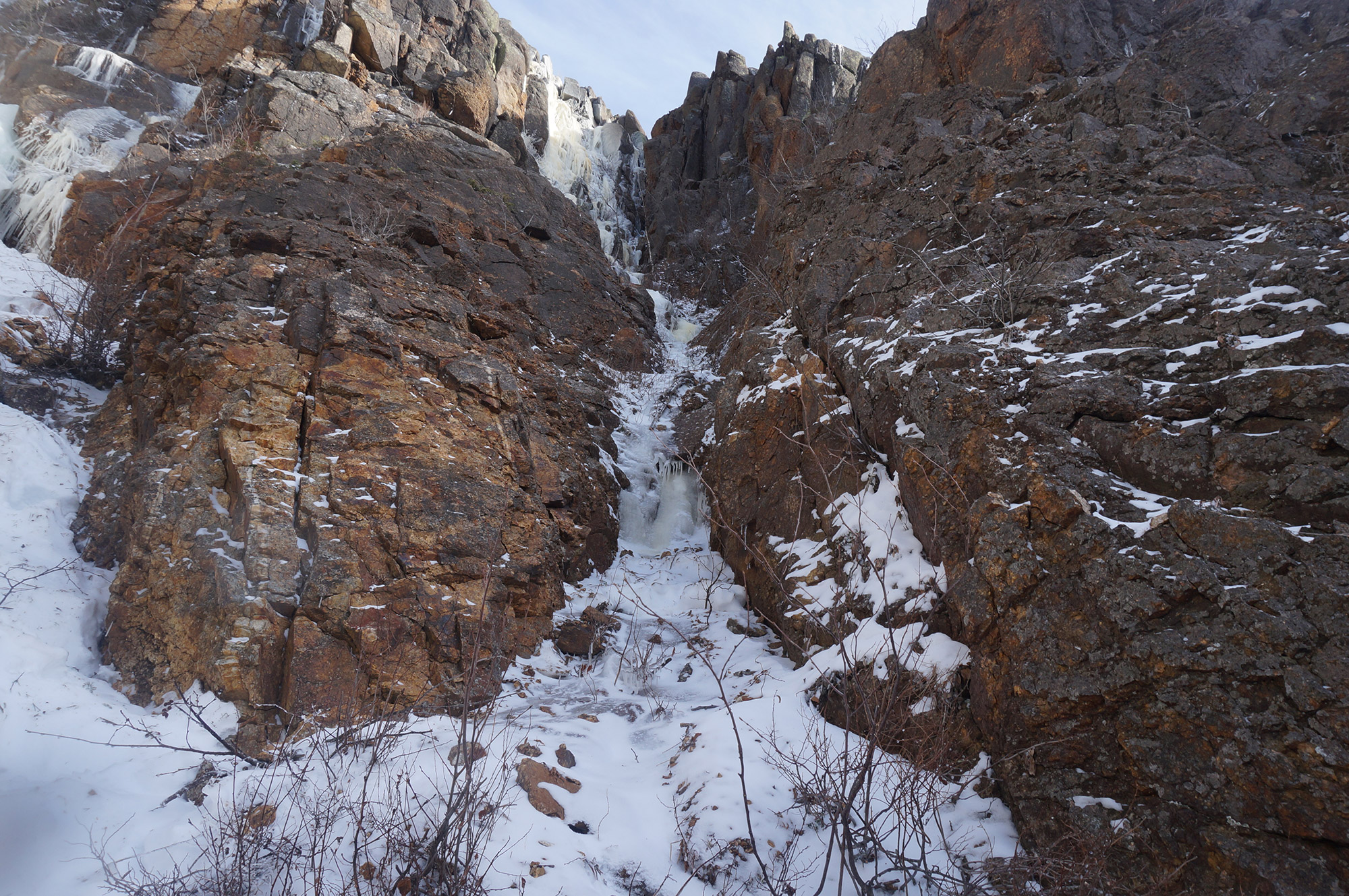
Optional Finishes
Shoestring Gully offers two alternative finishes for those looking to do more than simply slog up the snow at the top of the gully. The first option involves climbing the obvious rock wall on climber’s right roughly one rope length below the woods. The climbing is moderately rated at 5.5, but finding protection can be tricky, especially if the ice is thin. The second alternative is found above the rock finish and involves climbing a corner with ice rated up to WI3.
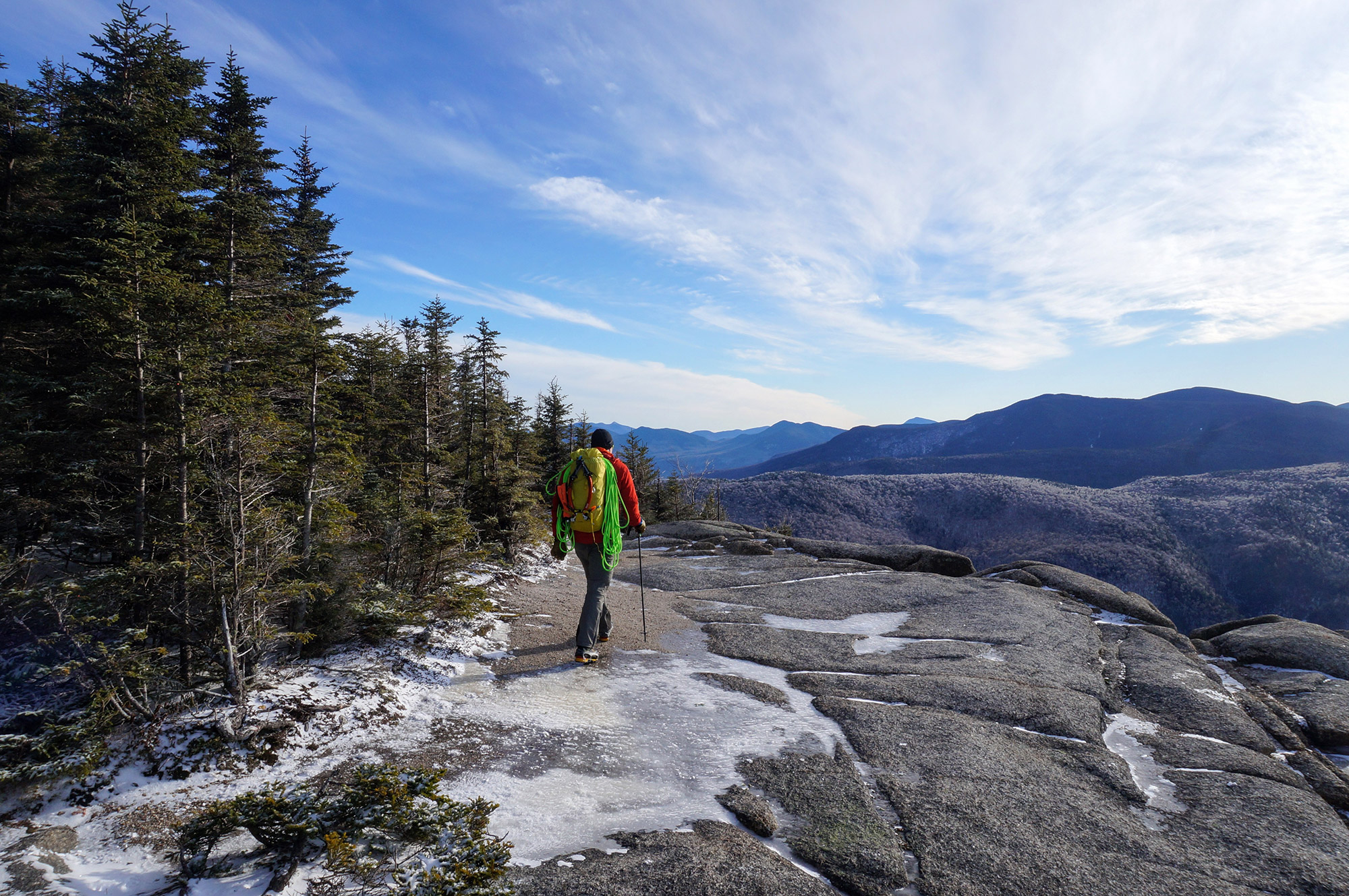
The Descent
From the proper finish, climbers should continue walking into the woods until they reach the Webster Cliff Trail (44.179947, -71.382828). The path to the Webster Cliff Trail is often well-broken in, making it easy to locate. The intersection of Shoestring Gully and the Webster Cliff Trail is a great spot to regroup, pack away climbing gear, and have something to eat. Once everything is packed and you’ve refueled, simply follow the Webster Cliff Trail back to Route 302 and your vehicle. As you head down, make sure to stop at the overlook just a few minutes from the top for a fantastic view of Mount Willard, Mount Willey, and the rest of Crawford Notch.
Pro Tip: If you didn’t bring MICROspikes, leave your crampons on for the descent. The Webster Cliff Trail descends several steep sections and is often extremely icy. You’ll want the extra traction.
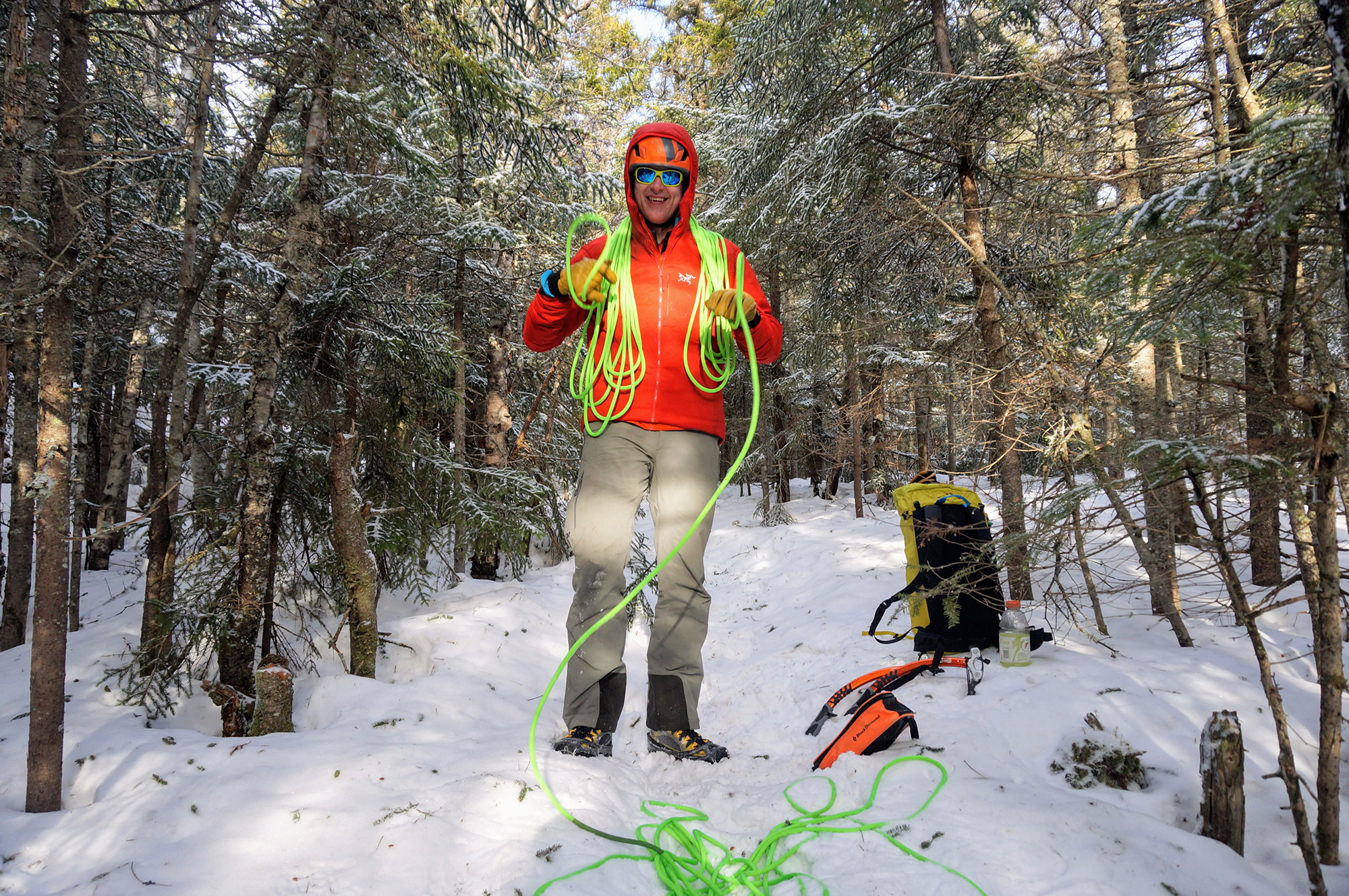
The Kit for Climbing Shoestring Gully
- Shoestring Gully gets a lot of traffic and the potential for someone knocking ice down the gully is high. We wouldn’t consider climbing it without a helmet, and the Petzl Sirocco Helmet is a long-time favorite of ours for its great fit and minimal weight.
- Lugging a heavy rope 2,500 feet up Shoestring Gully is no fun. Consider lightening the load with the Sterling Rope Fusion Nano 9.0 mm dry rope.
- The Black Diamond Dirtbag Gloves are just warm enough for most winter days, durable enough for ice climbing, and offer enough dexterity to handle the rope, making them a key to any Shoestring Gully kit.
- Whether you’re pitching it out, simul-climbing, or mixing the two techniques, an ascent of Shoestring Gully often involves a lot of stops and starts. A jacket like EMS’s Hooded Featherpack Jacket (men’s/women’s) is perfect for providing insulation and keeping you warm when stopped at belays.
- Winter days are short and everything from conditions to other parties can conspire to make the day longer than anticipated. Avoid getting stuck in the dark with the super bright and easily rechargeable Black Diamond Storm 500-R.
- The Petzl Caritool Evo can be added to most harnesses and makes it easy to keep your climbing gear organized.
- Not sure if you’re ready for Shoestring Gully? Contact the EMS Climbing School and arrange for a guided ascent or spend a day brushing up on your ice skills with one of our guides.
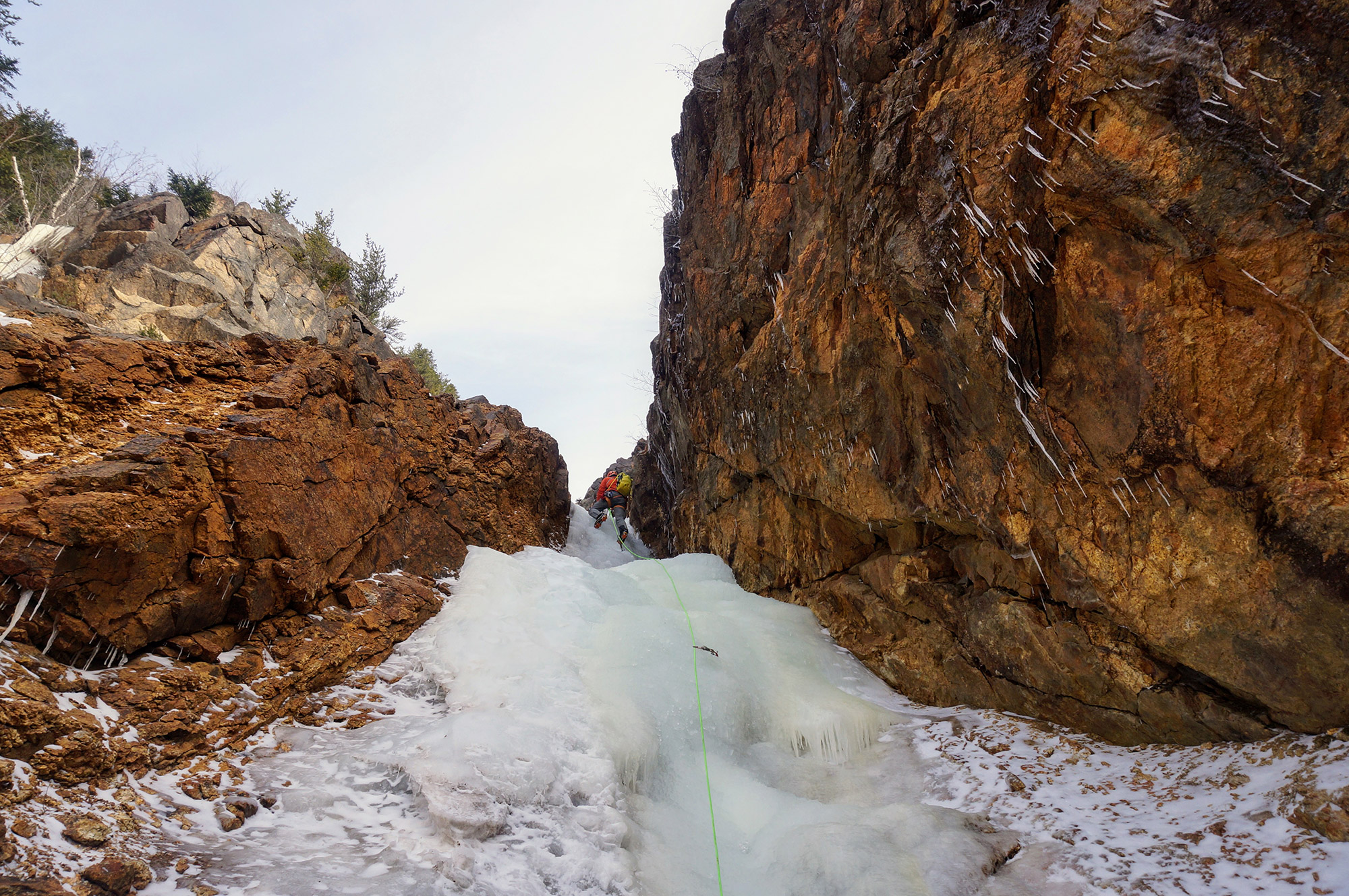
Keys to Climbing Shoestring Gully
- Get there early! This is a popular climb and arriving early is the surest way to beat the crowds.
- Shoestring Gully gets lots of sun, so it’s a great option even on cold days.
- Be willing to do variations, as there is ample opportunity to pass slower parties by doing different (sometimes harder) variations of the route’s pitches.
- Thanks to Shoestring Gully’s moderate grade and fun climbing, expect to encounter people of all abilities—from people taking their first turn on the sharp end to climbers going ropeless.
- If you finish with time to spare, consider climbing to the summit of Mount Webster, approximately mile and a half farther up the Webster Cliff Trail, or contemplate climbing another of the area’s moderate multi-pitch routes (Willey’s Slide, Flume Cascade, and Silver Cascade are all good nearby options).
- If you worked up an appetite while climbing, Fabyan’s Restaurant, located across from Bretton Woods, is just up the road, or head into North Conway and visit Moat Mountain Smokehouse and Brewery, which is the place for climbers to congregate.
Current Conditions
Have you climbed Shoestring recently? Post your experience and the conditions (with the date of your climb) in the comments for others!
Tim Peck and Doug Martland
Tim and Doug met long ago at the Eastern Mountain Sports in Canton, Massachusetts. Bonding over a love of slick Quincy Quarry granite, White Mountain sufferfests, and scheming up adventures while folding tee-shirts, today Tim and Doug collaborate to write about their favorite outdoor activities and occasionally get nostalgic about tee-shirt tables.
Related Posts
April 12, 2024
Explore Like a Local: The Outdoor Mecca of North Conway, NH
There's a lot to love about this New…
April 3, 2024
5 Things To Do in the Boston Area During Mud Season
Adventure opportunities are abundant…
1 Comment
Comments are closed.





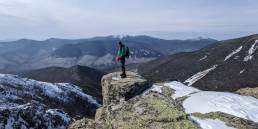
Great article, and the pictures are awesome.